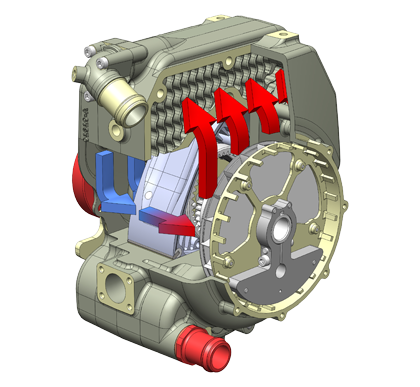
Posted on 04/15/2017 6:06:44 AM PDT by meatloaf
We already effectively have that, with subs like the Ohio, which were modified to be able to carry up to 154 Tomahawk missiles.
One nice addition would be a new class of submarine tender which could quickly re-stock an Ohio-class with another batch of Tomahawks.

A large one Curtiss Wright I believe...

"SPARCS"

Google Pratt and Whitney and Turbo Compound Rotrary, a lot of patents coming out of the Canadian Division.
A Burke-class destroyer costs like a billion dollars. Wasn’t that long ago you could buy a carrier for that. But you’re going to need the range, sea-keeping & sensor package that the Burke carrys. Something similar will be the platform for the new laser, drone & ABM battleground capabilities.
You’re not going to recover those drones. Make them on the cheap and let them fall into the ocean after the mission. They need no weapons, just swarm the attacking missile or aircraft and crash into it or explode with an expanding rod warhead.
The “Arsenal Ship”. A very high-value target. BTW, nobody makes battleship armor anymore. That was a specialty steel that doesn’t exist any longer. You might be able to do something akin to composite armor used on the M1A2 tank, but only on selected internal areas of the vessel.
“...Frigates. Like Old Ironsides during the days of sail. And lots of them.”
A misreading of what “Old Ironsides” (USS Constitution) actually was. Fails to recall how she got her nickname.
Designed by Joshua Humphreys, USS Constitution was built bigger & heavier than typical frigates of the late 18th century, mounting so many guns that some navy-watchers suggested she ought to be a fifth- or sixth-rate “ship of the line” (as battleships were termed then). Her hull contour and square yardage of spreadable canvas permitted her to outspeed all other warships and match other frigates.
British Royal Navy captains found - to their discomfiture - that Constitution could bring their frigates to battle, during which her main armament (with greater numbers of “long guns”) could outrange their carronades (large caliber, but of lower velocity); solid shot fired from RN carronades were observed to bounce off her sides, greatly boosting the morale of her sailors and earning her nickname.
When Constitution and her sister ships were being designed, Humphreys ran into resistance: his “super frigates” would cost more per ship; many naval authorities and government officials wanted smaller, simpler vessels in greater numbers. He refused to compromise and got enough leaders to back him; the strength & seaworthiness of his ships occasioned a lot of notice around the globe, before they went into action and cemented his reputation. And - not so incidentally - proved the courage of American sailors, and the prowess and professionalism of the fledgling US Navy.
Joshua Humphreys was a Quaker. The Society of Friends ultimately kicked him out because he built such fine weapons of war.
Negates Redmen4ever’s final point about “Lots of them.”
“Make them on the cheap and let them fall into the ocean after the mission.”
I absolutely agree on making them cheap, but the drones I envision are not airborne, but rather very fast boats just large enough to support the gatling gun, a couple small missiles, and whatever the latest underwater anti-torpedo ‘missile’ is.
They developed something like that a while back for harbor defense. I believe it was one of those ideas to protect harbors after 9/11.
My suggestion would be a few dozen diesel subs with AIP. Quieter than a nuke, great for coastal patrol, the GOM, and regional force projection.
It’s the computing programs and power that would make it very effective. Some of them could be quite a distance away from the carrier group, others closer in. Take it a step further and incorporate some flying drones as you suggest as well.
Step one: recreate the technology to again make battleship armor ...

Sorry, but we no longer have the rolling mills of the size required to produce the armour plate for an Iowa class battleship.
“... floating island thats at least a mile long. ... tall towers ... reach past the curvature of the earth, ... definitely can handle the largest aircraft ... a psychological point of extreme power. ... “
Too small for the largest aircraft. They need runways between two and three miles (13,500 ft) long.
Won’t work with current carrier-based aircraft: they require a vessel speed of over 30 knots to launch - even with steam catapult help. Requires powerful propulsion: limits size & weight of ship.
Directed energy weapons (lasers) haven’t been developed to hit targets so far out. Railguns cannot hit anything so far out either: projectile would require guidance and course-correction subsystems, which cannot survive acceleration of launch.
No “skyscraper” tower can be tall enough: at altitudes of 80,000 ft, SR-71 crews could see 350 miles. Geosynchronous satellites orbit more than 23,000 miles: three satellites are still required to reach evey point on earth.
Geometry beats psychology.
Modular
Steel
Railguns
Lasers or (frikin’ lasers)
Drones
Or a small drone carrier
Jet powered catmarans for duty comparable to the old PT boats give width and stability for a fast ship able to go into shallow waters not suitable for deep draft monohulls.
Make them a stealthy design without flat surfaces and use some new stealth material to prevent radar discovery.
Of possible interest Ping...
Two issues to deal with - structural integrity and keeping the water out. Traditionally, they’ve been dealt with as a single problem. Maybe they need to be looked at separately.
Disclaimer: Opinions posted on Free Republic are those of the individual posters and do not necessarily represent the opinion of Free Republic or its management. All materials posted herein are protected by copyright law and the exemption for fair use of copyrighted works.